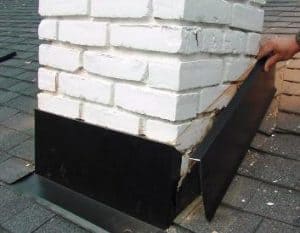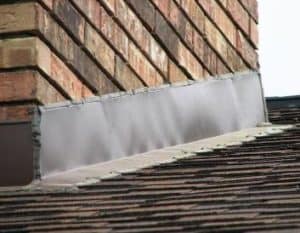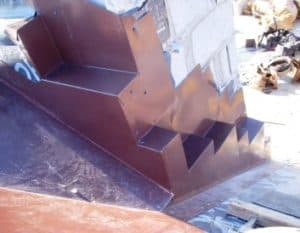As a Waukesha county residential exterior contractor, Total Exterior Pros has had to repair or replace hundreds of roof flashing’s, including chimney flashing’s. In many cases these critical flashing’s failed or were installed incorrectly. Naturally there were problems of leaking with resulting damage to the roof decking, insulation, drywall, and even the roof structure. With the chimney being the largest component that protrudes through the roofing system, it is critical that proper fabrication and installation methods are followed to ensure the integrity and longevity of your roof. The following information focuses on roof protrusions, specifically chimney flashing systems.
The number one vulnerability to the integrity of any roofing system is any vent that protrudes through the roofs waterproof barrier. Roof protrusions or “components” consist mainly of plumbing ventilation pipes, bathroom and kitchen vents, and chimneys. Because these components are necessary, and yet compromise the integrity of the roofing system, they must have proper flashing to protect against water infiltration. Essentially, flashing’s come in a variety styles that are made of metal, plastic, rubber, or combinations of metal and rubber. Flashings surround the component to seal the void between the component itself and the roof deck.

Chimney Flashing Systems
Of all the various roof protrusions, chimneys are one of the most complex and problematic components to protect from water infiltration and roof leaks. This is because chimneys are typically made of brick or stone. Unlike other roof protrusion components such as plumbing pipes; which are symmetrical and have a surface that is easily sealed – brick and stone vary in size, shape, and have surfaces that are jagged, uneven, and challenging to seal. Because of their irregular surface and mortar joints, chimneys require more complex flashing systems to create an effective water tight barrier to shed water away.
Depending upon the location on the roof, a typical chimney will have step tins on the two sides of the chimney, a piece of 4×4 on the lower side of the chimney, and a back flash or cricket on the back side of the chimney. Some chimneys are centered in the ridge or located along a gable edge and require various combinations of these four flashing components.
In most cases, however, mounted over the top of the step tins, 4×4, back flash, or cricket will be a counter flashing that prevents water from getting behind these components. Because roofing contractors implement different flashing applications, not all chimney flashing systems are the same. Typical chimney flashing systems include two-piece flashing’s, one piece flashing’s, and through wall flashing’s, but opinions vary among professional roofers as to which chimney flashing system is the best. However, most roofing contractors would agree that the most common is the two-piece chimney flashing system.
The following is an overview of the three popular chimney flashing systems.
Two-Piece Chimney Flashing System:
 A two-piece chimney flashing consists of step tins and counter flashing. Although called a two-piece system, in reality there are four counter flashing pieces. The term “two-piece” represents the fact that a separate piece of metal flashing covers the upper three-quarters of the lower flashing components. (i.e., step tins, 4×4, and back flash or cricket.)
A two-piece chimney flashing consists of step tins and counter flashing. Although called a two-piece system, in reality there are four counter flashing pieces. The term “two-piece” represents the fact that a separate piece of metal flashing covers the upper three-quarters of the lower flashing components. (i.e., step tins, 4×4, and back flash or cricket.)
Ideally the two-piece system is one of the best flashing systems to use when replacing or repairing a defective chimney flashing. The two-piece system allows for movement (expansion and contraction) of the chimney during various weather conditions without separating from the chimney and compromising the water seal.
Two-Piece Chimney Flashing System:
 A one-piece chimney flashing consists of an L-shaped piece of metal that diverts water off and away from the chimney and on to the roof. Again, although called a one-piece system, in reality there are four separate flashing pieces that surround and attach to the chimney.
A one-piece chimney flashing consists of an L-shaped piece of metal that diverts water off and away from the chimney and on to the roof. Again, although called a one-piece system, in reality there are four separate flashing pieces that surround and attach to the chimney.
In a majority of the cases one piece chimney flashing’s are vulnerable to failing because they become separated from the chimney through expansion and contraction.
Through-Wall Chimney Flashing:
 Although roofers implement various types of chimney flashing techniques, the most effective chimney flashing is a metal through-wall flashing system. Unlike the more common two-piece chimney flashing which consists of step tins and counter flashing, a metal through-wall flashing can only be implemented under two circumstances: a) during the initial construction of the chimney, or b) if the chimney is being rebuilt and the stone or brick is being removed.
Although roofers implement various types of chimney flashing techniques, the most effective chimney flashing is a metal through-wall flashing system. Unlike the more common two-piece chimney flashing which consists of step tins and counter flashing, a metal through-wall flashing can only be implemented under two circumstances: a) during the initial construction of the chimney, or b) if the chimney is being rebuilt and the stone or brick is being removed.
One of the benefits of the through-wall flashing system is that it is built right into the structure of the chimney system. As such, there is very little room for failure due to expansion and contraction, and this system works the longest at diverting water away from the chimney protrusion.
If you are a home or business owner and you are experiencing a roof leak, the likelihood of the leak source being a roof protrusion or failed chimney flashing is relatively high. Because many of the homes in Waukesha and Milwaukee are relatively older, more modern and conventional flashing systems were not around when the chimney was originally constructed and it simply failed due to age. On the other hand many Southeastern Wisconsin roofing contractors simply use a one piece flashing system because it is cheaper and easier to install. The problem is that it will surely fail, so before you hire a roofing contractor, ask them what type of chimney flashing they will be installing, and insist on a two-piece chimney flashing system if you want it to last.

